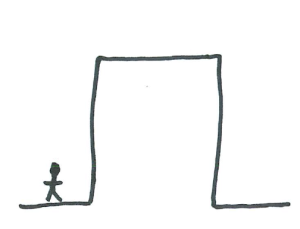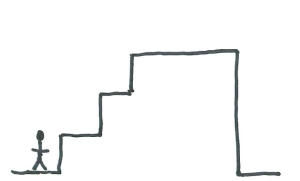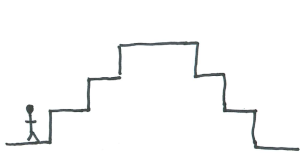Habit failure happens for me often. I make a habit or resolution, and inevitably, I break it. Yet people still consider me a disciplined person who’s good at keeping resolutions.
I have a secret: I recover well.
Today, in fact, is a major recovery day. I’ve been working on six daily habits. I broke my daily networking habit last month when work got intense. Then this past Wednesday, I broke all the rest in one fell swoop.
Recovering from habit failure is an rarely discussed key to habit success. Today, in honor of restarting all of my daily habits, and to fulfill my monthly blog post habit, I’ll discuss my strategies for recovering from habit failure.
How I Used To Approach Habits
I used to approach habits as an all-or-nothing venture. I either met my goal or didn’t.
I set high goals too. I wanted to push myself and get inspired by being ambitious.
I treated habits like a cliff face I had to scale. But climbing a cliff each time you need to start a habit can be discouraging. Big leaps can be tiring.

I switched to a staircase approach to starting a habit. I’d increase gradually, building up my willpower and gaining momentum. But when I fell, I still fell hard. The cliff was still waiting for me on the other end.

My New Approach
Now I use a staircase on both ends. I have small steps to build a habit and small stumbles to recover when I mess up. I rarely have a big fall anymore.

What do I mean by small stumbles?
I build stumbles into how I approach habits.
For exercise, I have a simple rule: exercise every day. I make it a priority, so most days it happens. But sometimes it doesn’t. When that happens, I have a fallback rule: skip no more than 2 days without exercising.
Because of this, when I break my exercise habit, I haven’t broken it entirely. I’ve moved to a lower level of commitment. This makes it easier to get back up.
I set low expectations.
For exercise, my complete rule is: exercise every day for at least 10 minutes. My real goal is to get 30-40 minutes of exercise a day. But by setting a low bar for success, I make it easier to keep my habit on days I’m feeling weak or busy.
That works well for my psychology. I like streaks and not having my habits broken.
Ultimately, I manage the momentum of my habits.
Rather than coming to a full stop, I decelerate. I shift to lower levels of effort.
Just like a car, getting back up to speed with my habits is easier if I have momentum. And if I do completely break my habit, small steps help me restart easily and get rolling again.
Sometimes though, like this week, I lose all momentum.
To get restarted, I commit to a restart date. Before that date, I don’t waste my effort trying to do my habit. Half-hearted habits can quickly drain my resolve.
Instead, I prepare my environment and my psyche to restart on that date.
I like to start on significant days–even if the significance is arbitrary. The first day of the week, month or quarter resonates with me, or, as I’m discovering today, the 15th of the month, as the halfway point.
Finally, I set a lower bar when traveling or on vacation.
Setting a lower level of commitment allows me to maintain momentum and keep my habit going in some form, making it easier to ramp back up when I return home. I’m also starting to play with habits that only kick in while travelling.
In the end, habits are only habits if you do them regularly. All of my strategies aim to meet that one goal: do habits regularly.
What strategies do you use to recover from habit failure?
1 comment
NS Manjunath says:
April 20, 2017 at 11:55 am (UTC -4)
Works for me! Excellent tip!